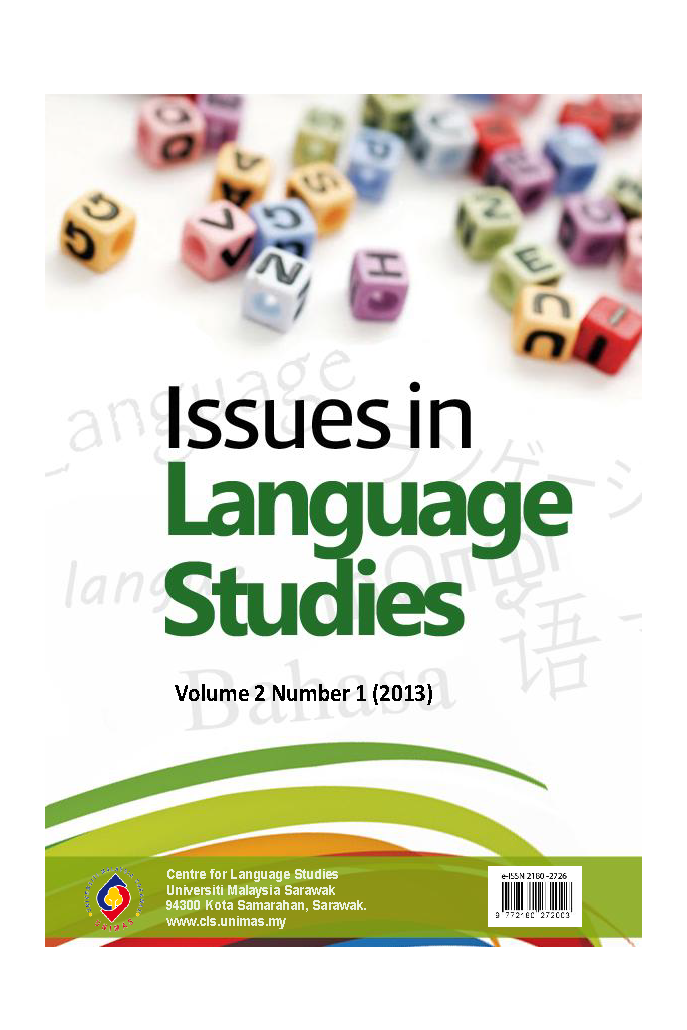Abstract
Kewujudan pelbagai aplikasi berasaskan media sosial telah menawarkan satu wadah yang baik untuk para pengajar memaksimumkan penggunaan aplikasi tersebut dalam pendidikan. Kajian ini mengenal pasti persepsi pelajar tentang penggunaan aplikasi media sosial dalam pengajaran Bahasa Inggeris yang melibatkan sejumlah 100 orang pelajar prasiswazah yang mengikuti kursus pengukuhan Bahasa Inggeris. Mereka dikehendaki untuk melibatkan diri dalam aktiviti-aktiviti berasaskan media sosial yang dijalankan dalam laman e-pembelajaran kursus tersebut selama 10 minggu. Pada penghujung minggu ke-10, borang soal selidik diberikan kepada pelajar untuk mengenal pasti persepsi mereka tentang aktiviti-aktiviti yang telah dijalankan. Dapatan kajian menunjukkan para pelajar berpendapat Wiki telah membantu penulisan mereka, manakala video YouTube banyak digunakan untuk meningkatkan penguasaan kemahiran bertutur. Selain itu, kumpulan perbincangan Facebook dianggap berguna untuk pembelajaran tatabahasa dan perkataan. Twitter pula hanya digunakan untuk menerima informasi tentang definisi perkataan. Perbincangan tentang kekuatan dan kelemahan media sosial dalam pembelajaran Bahasa Inggeris dan cadangan untuk meningkatkan potensi aplikasi tersebut juga disertakan.
References
Annand, D. (2011). Social presence within the community of inquiry framework. The International Review of Research in Open and Distance Learning, 12(5), 40-56.
https://doi.org/10.19173/irrodl.v12i5.924
Azer, S. A. (2012). Can YouTube help students in learning surface anatomy? Surgical and Radiologic Anatomy, 34(5), 465-468.
https://doi.org/10.1007/s00276-012-0935-x
Boyd, D. (2010). Streams of content, limited attention: The low of information through social media. EDUCAUSE Review, 45(5), 26-36.
Chambers, A. (2010). Computer-assisted language learning: Mapping the territory. Language Teaching, 43(1), 113-122.
https://doi.org/10.1017/S0261444809990279
Huang, H. T., & Hung, S. T. (2009). Implementing electronic speaking portfolios: Perceptions of EFL students. British Journal of Educational Technology, 41(5), 84-88.
https://doi.org/10.1111/j.1467-8535.2009.00996.x
Hunter, R. (2011). Erasing "property lines": A collaborative notion of authorship and textual ownership on a fan Wiki. Computers and Composition: An International Journal for Teachers of Writing, 28(1), 40-56.
https://doi.org/10.1016/j.compcom.2010.12.004
Kaplan, A. M., & Haenlein, M. (2010). Users of the world, unite! The challenges and opportunities of social media. Business Horizons, 53(1), 59-68.
https://doi.org/10.1016/j.bushor.2009.09.003
Kern, R. (2006). Perspectives on technology in learning and teaching languages. TESOL Quarterly, 40(1), 183-210.
https://doi.org/10.2307/40264516
Kop, R. (2011). The challenges to connectivist learning on open online networks: Learning experiences during a massive open online course. The International Review of Research in Open and Distance Learning, 12(3), 19-38.
https://doi.org/10.19173/irrodl.v12i3.882
Kesseler, G. (2009). Student-initiated attention to form in Wiki-based collaborative writing. Language Learning & Technology, 13(1), 79-95. Retrieved from http://llt.msu.edu/vol13num1/kessler.pdf
Kessler, G., Bikowski, D., & Boggs, J. (2012). Collaborative writing among second language learners in academic web-based projects. Language Learning and Technology, 16(1), 91-109. Retrieved from http://llt.msu.edu/issues/february2012/kesslerbikowskiboggs.pdf.
Roblyer, M. D., McDaniel, M., Webb, M., Herman, J., & Witty, J. V. (2010). Findings on Facebook in higher education: A comparison of college faculty and student uses and perceptions of social networking sites. The Internet and Higher Education, 13(3), 134-140.
https://doi.org/10.1016/j.iheduc.2010.03.002
Wardrip-Fruin, N., & Montfort, N. (2003). The new media reader. Cambridge: MIT Press.
Weller, M. (2011). A pedagogy of abundance. Spanish Journal of Pedagogy, 249, 223-236.
Copyright Transfer Statement for Journal
1) In signing this statement, the author(s) grant UNIMAS Publisher an exclusive license to publish their original research papers. The author(s) also grant UNIMAS Publisher permission to reproduce, recreate, translate, extract or summarize, and to distribute and display in any forms, formats, and media. The author(s) can reuse their papers in their future printed work without first requiring permission from UNIMAS Publisher, provided that the author(s) acknowledge and reference publication in the Journal.
2) For open access articles, the author(s) agree that their articles published under UNIMAS Publisher are distributed under the terms of the CC-BY-NC-SA (Creative Commons Attribution-Non Commercial-Share Alike 4.0 International License) which permits unrestricted use, distribution, and reproduction in any medium, for non-commercial purposes, provided the original work of the author(s) is properly cited.
3) For subscription articles, the author(s) agree that UNIMAS Publisher holds copyright, or an exclusive license to publish. Readers or users may view, download, print, and copy the content, for academic purposes, subject to the following conditions of use: (a) any reuse of materials is subject to permission from UNIMAS Publisher; (b) archived materials may only be used for academic research; (c) archived materials may not be used for commercial purposes, which include but not limited to monetary compensation by means of sale, resale, license, transfer of copyright, loan, etc.; and (d) archived materials may not be re-published in any part, either in print or online.
4) The author(s) is/are responsible to ensure his or her or their submitted work is original and does not infringe any existing copyright, trademark, patent, statutory right, or propriety right of others. Corresponding author(s) has (have) obtained permission from all co-authors prior to submission to the journal. Upon submission of the manuscript, the author(s) agree that no similar work has been or will be submitted or published elsewhere in any language. If submitted manuscript includes materials from others, the authors have obtained the permission from the copyright owners.
5) In signing this statement, the author(s) declare(s) that the researches in which they have conducted are in compliance with the current laws of the respective country and UNIMAS Journal Publication Ethics Policy. Any experimentation or research involving human or the use of animal samples must obtain approval from Human or Animal Ethics Committee in their respective institutions. The author(s) agree and understand that UNIMAS Publisher is not responsible for any compensational claims or failure caused by the author(s) in fulfilling the above-mentioned requirements. The author(s) must accept the responsibility for releasing their materials upon request by Chief Editor or UNIMAS Publisher.
6) The author(s) should have participated sufficiently in the work and ensured the appropriateness of the content of the article. The author(s) should also agree that he or she has no commercial attachments (e.g. patent or license arrangement, equity interest, consultancies, etc.) that might pose any conflict of interest with the submitted manuscript. The author(s) also agree to make any relevant materials and data available upon request by the editor or UNIMAS Publisher.

